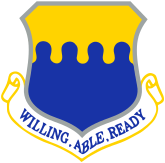This article needs additional citations for verification. (January 2013) |
| 43rd Airlift Wing | |
|---|---|
 A 43rd Operations Group C-130 flies over the Cape Hatteras lighthouse along the North Carolina coast | |
| Active | 1947-1970; 1970-1990; 1992-1996; 1997-2011 |
| Country | |
| Branch | |
| Role | Airlift |
| Motto(s) | Willing, Able, Ready |
| Decorations | Presidential Unit Citation Air Force Outstanding Unit Award w/ V Device Philippine Presidential Unit Citation Republic of Vietnam Gallantry Cross w/ Palm |
| Commanders | |
| Notable commanders | David A. Burchinal Jack J. Catton |
| Insignia | |
| 43rd Airlift Wing emblem (approved 18 November 1993) |  |
| 43rd Bombardment Wing emblem (approved 14 May 1968)[1] |  |
The 43rd Airlift Wing is an inactive United States Air Force unit last stationed at Pope Field, part of Fort Bragg, North Carolina, where it was inactivated in March 2011. The wing performed en route operations support at Pope Field to include mission command & control, aircrew management, aircraft maintenance, aircraft loading, aircraft fueling and supply. Since the wing's inactivation, the 43rd Airlift Group has carried out airlift, maintenance, and base support at Pope Field.
The wing provided strategic, en-route airlift support and Lockheed C-130 Hercules tactical airlift support to the Army's XVIII Airborne Corps and 82nd Airborne Division. The wing traces its roots back to the 43rd Bombardment Group (Heavy), which was constituted 20 November 1940, and activated 15 January 1941, at Langley Field, VA. It operated primarily in the Southwest Pacific Theater as a Boeing B-17 Flying Fortress, and later a Consolidated B-24 Liberator heavy-bomber unit assigned to Fifth Air Force. The 43rd Operations Group carries the lineage and history of its highly decorated World War II predecessor unit.
Active for over 60 years, the wing was a component wing of Strategic Air Command's deterrent force throughout the Cold War.
- ^ Ravenstein, pp. 70–73